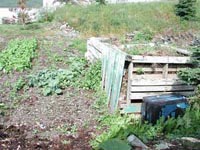Resource Library
Plant of the Week: Composting leaves | Fall compost in Arkansas
The University of Arkansas System Division of Agriculture does not promote, support or recommend plants featured in "Plant of the Week." Please consult your local Extension office for plants suitable for your region.
Plant of the Week
Composting Fall Leaves

Fall is in full swing at my house. The spiraling descent of oak leaves and the bong of acorns on the roof marks the beginning of another gardening season. After the leaves are taken care of, it will be time to sit back and dream and scheme of projects to make my little corner of paradise even that much better. But first, the leaves.
The 'natural' solution
The hillside where I live produces lots of leaves and each neighbor has developed a routine for dealing with the season's abundance. Some choose to deal with them by not dealing with them. This natural approach allows the forces of nature -- wind, water and time -- to do with them what they will.
I use this approach on the non-lawn portions of my landscape. The decaying leaves form a nice beige carpet that protects little plants and gives a pleasant, uniform look during winter. But, of course, leaves tend to blow around, so therein lies a problem.
One fall, having way too much time on my hands, I undertook a research project to solve the blowing leaf problem. I went to the lumber yard and came home with giant aerosol cans of spray adhesive. Figuring that a light application of adhesive would stick the leaves together, I set to work spraying. All went well until my wife let the dog out. It was not a pretty sight.
Bagging leaves
Then there are the baggers. Baggers like to keep us posted on their bagging tally. But, at least in my neighborhood, few bags ever seem to make it to the city compost yard. Every fall you see old pickups or Lincoln Navigators prowling the streets looking for bags to claim. As the bags are loaded, these leaf pirates cast furtive glances over their shoulder to make sure the boys in blue aren’t going to suddenly appear and haul them off to the slammer.
Composting leaves
But, of course, the best way to deal with leaves is to compost them. I find composting a rewarding experience, probably because it satisfies my tendencies towards cheapness. The idea of getting something useful from nothing is very appealing; plus it doesn’t take a lot of work.
Before launching a career in composting, you must first decide if you will be an active or passive composter.
Active composters have things like long- stemmed thermometers and all the latest gadgets. Many apparently suffer from an obsessive-compulsive disorder for they are always turning their pile, checking its temperature or otherwise assisting in the process of decay.
Compost piles
The rest of us have compost piles. Nothing fancy, just a pile. My average size city lot produces about 15 cubic yards of leaves every fall. The leaves are raked onto a tarp and hauled Santa Claus-style up the hill to my dog pin-size compost pile. With each dump of leaves, I throw on a couple handfuls of fertilizer to speed the process of decay. I could reduce the volume and speed the rate of decay by running the leaves through a shredder, but I have neither a shredder nor the patience to force the leaves through the machine. Time is my ally.
Just before leaf raking time, I fork the composted leaves from last season into a new, and much smaller pile where they await use the following spring. The volume will have shrunk to about a tenth of its original size.
I use the compost as a mulch in my woodland garden, applying a generous 3- to 4-inch topdressing to the beds.
By: Gerald Klingaman, retired
Extension Horticulturist - Ornamentals
Extension News - October 17, 2003